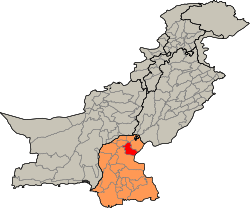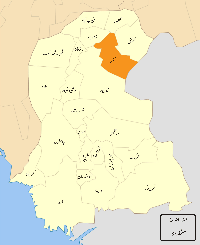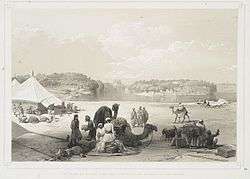Sukkur District
| Sukkur District ضلعو سکر | |
|---|---|
| District | |
 | |
 Map of Sindh with Sukkur District highlighted | |
| Coordinates: 27°40′N 69°30′E / 27.667°N 69.500°ECoordinates: 27°40′N 69°30′E / 27.667°N 69.500°E | |
| Country | Pakistan |
| Province | Sindh |
| Headquarters | Sukkur |
| Number of Tehsils | 4 |
| Population (2015) | |
| • Total | 2,125,122[1] |
| Time zone | PST (UTC+5) |
| Website |
www |
Sukkur district (Sindhi: ضلعو سکر), is a district in Sindh Province in Pakistan. It is divided into 4 administrative strata (tehsils), namely; Sukkur City, Rohri, Saleh Pat and Pano Aqil. Among them Sukkur city and new Sukkur are urban centre while Pano Aqil is famous for having one of largest military cantonment of the country. Rohri is the smallest tehsil of the Sukkur district, both in area and population but it has one of ancient and important railway junction.
Administrative divisions
| Tehsil | Population (2015) |
Area (km²) |
Union Councils |
Villages |
|---|---|---|---|---|
| Sukkur | 955,000 | 274 | 20 | 50 |
| Rohri | 471,510 | 1319 | 11 | 400 |
| Saleh Pat | 178,462 | 2339 | 03 | 250 |
| Pano Aqil | 520,150 | 1233 | 12 | 450 |
| Total | 2,125,122 | 5165 | 46 | 1150 |
According to the 2010 estimations of Pakistan, at least 59.50% of the population of Sukkur district were urban, making it the third-most advanced district in Sindh.[2]
Demographics

At the time of Pakistan's independence in 1947, Sukkur district comprised approximately 200,000 inhabitants, mostly engaged in agricultural pursuits and fishing industry. Over time, Sukkur has seen a moderate rise in population (2 to 2.5% per annum) as compared to Pakistan's, except in late 1960s and early 70s when population growth rate reached 4.43% (1972 census) due to internal migration and establishment of some large bridges on river Indus. According to official census of 1998, Sukkur has 908370 inhabitants and density of 175.9 persons per square kilometre. The current estimate (on the basis of 3.27 annual growth)[3]
| Historical population | |||||||||||||||||||||||||
|---|---|---|---|---|---|---|---|---|---|---|---|---|---|---|---|---|---|---|---|---|---|---|---|---|---|
|
| ||||||||||||||||||||||||
.jpg)
Sukkur district is chiefly populated by Muslims that constitute 96% of the total population. The minorities include: Hindus 3.28% and Christians about 0.51%. Hindus are mostly settled in urban areas and are engaged in the trade and services sectors. The independence of Pakistan in 1947 saw the influx of Muslims which include Urdu-speaking Muhajirs, Bandhani-speaking Rajputs from Rajasthan, Memons from Bombay, Gujrat and Kathiawar were migrated from India and settled here, mostly in the aftermath of anti-Muslim riots when Pakistan was carved out of India as the result of Muslim vote; the muslim population of India voted for their separate homeland, the Pakistan. While some of the Bandhani, Memons, and Punjabis were settled here before partition, i.e., the independence of Pakistan in 1947. Traditionally Memons were associated with trade and retail business but during last two decades they have ascended as an active social and economic front. Sukkur is noteworthy in Sindh and Pakistan generally for its comparative tolerance towards religious and ethnic minorities. City is a multi-ethnic and has a mix of Sindhis, Punjabis, Brahuis, Balochis and Pakhtuns. The biggest segment of population in District Sukkur Sindhis (77.58%), followed by Muhajirs (11.50%); Punjabi (4.50%); Pashto (2.50%); Baluchi (1.00%); Seraiki (0.92%) and others (2.00%). Sindhis are native to the area and speak its various dialects, including, Utradi, Lari, Siraiki, Thari, Dadhki, etc. A large number of Punjabis were attracted to the city after the Indus treaty settlement and are settled around the downtown and chowk Ghantaghar in central part of the city. Most Pakhtuns are distinct and separately living near the railway station and its vicinity. The city therefore has cosmopolitan atmosphere with multiethnic and multicultural communities.[4] Following are the demographic indicators of the district, The population of the district is according to 2,125,122 Population 2015:[5]
Religion
- Islam: 96.13%
- Hinduism: 3.28%
- Christianity: 0.51%
- Ahmaddiya: 0.04%
- Others: 0.1%
Language
- Sindhi: 78.75%
- Urdu: 12.50%
- Punjabi:3.35%
- Pashto:2.25%
- Baluchi:0.85%
- Seraiki:0.80%
- Others:1.50% (mainly Memoni, Marwari, Gujarati, Bihari Brahui and Kachi)
References
- ↑ "Sindh population surges by 81.5 pc, households by 83.9 pc". Thenews.com.pk. 2 April 2012. Retrieved 2013-04-21.
- ↑ Urban Resource Centre (2010 est.)
- ↑ "Sindh population surges by 81.5 pc, households by 83.9 pc". Thenews.com.pk. 2 April 2012. Retrieved 2013-04-21.
- ↑ Umair, Bisma (13 July 2013). "Sukkur".
- ↑ "Sindh population surges by 81.5 pc, households by 83.9 pc". Thenews.com.pk. 2 April 2012. Retrieved 2013-04-21.
